![]() 1st Battalion 22nd Infantry
1st Battalion 22nd Infantry ![]()
OPERATION UPHOLD DEMOCRACY
Haiti 1994
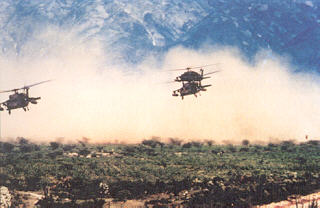
As the air assault of 19 September, 1994 occurred, 1/22 Infantry completed their flight from Griffis Air Force Base, and flew in to the Port-au-Prince International Airport behind the assault forces.
The mission of the forces under OPLAN 2380 was to:
Conduct military operations to restore and preserve civil order; protect US citizens and interests and designated Haitians and third country nationals; create a secure environment for the restoration of the legitimate government of Haiti; and provide technical assistance to the government of Haiti.
At the Brigade and Battalion level, this mission initially boiled down to providing security by "presence" and by patrolling with US soldiers in the streets of Port-au-Prince. Limited patrolling began on 20 September and continued as the Division expanded its lodgment in Haiti. At any given time, approximately one-third of 1st Battalion was engaged in patrolling.
The 1st Battalion 22nd Infantry quartered itself initially on the southwest corner of the International Airport. Not long afterward, higher headquarters began pushing to get American troop presence out in to the city. 1st Battalion pushed out via air assault and ground convoy to the downtown military airport, Bowen Field.
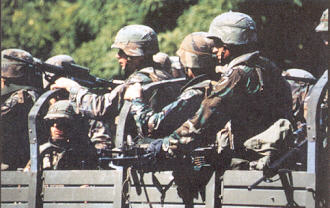
This airfield was originally the headquarters of the Haitian Air Force. There was concern over the occupation of this airfield, as this was potentially one of the first direct confrontations between US and Haitian military units since the landing. The operation went off with out any hindrance, and the airfield was secured and eventually occupied by the remainder of First Brigade, minus 2/22 Infantry and 1/87 Infantry, who maintianed their security positions at the airport and port, respectively. The compound at Bowen Field was given the name of Warrior Base.
Additional expansion of static security operations extended further into Port-au-Prince as key municipal and governmental buildings were indentified. Units rotated among several assignments, such as securing the Duvalier properties, General Cedras' house, various local officials' offices or residences, and eventually the national palace, soon to be the seat of power for the returning Prsident Aristide.
One of the major programs that 1/22 Infantry, along with other units, were involved in was a weapons buy-back program. The intent of this program was to remove, voluntarily, dangerous weapons and munitions from the streets of Haiti, in an effort not only to protect the local population, but also to enchance force protection for the soldiers in the Multi-National Force.
Payment price increased according to how dangerous the item was or what operational condition the weapon as in. The better the condition of the weapon, the more money was paid to the Haitian turning it in. Although the intent of the program was worthy, it was the opinion of many that this initiative was only marginally successful. Most of the weapons turned in were rusted and nonoperational, and most explosives appeared unstable and perhaps posed a greater danger to the soldiers and Haitians handling them at the turn-in station.
One such station manned by 1/22 Infantry was at the front gate of Bowen Airfield, a high traffic area for Haitian civilians and US units. In addition to the weapons buy-back program, 1/22 Infantry participated in the Division's "weapons cache operations." During these operations, units would conduct cordon and search operations to seize suspected weapons caches. Occaisonally, the search and seizure missions would be modified to include the detention of suspect Haitian personnel who were identified for apprehension and questioning.
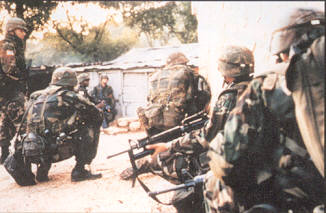
The operational focus during October for all Port-au-Prince units was clearly the return of President Aristide. Diplomatic efforts, combined with military efforts in security and stability, allowed for the safe return, after three years, of the democratically elected President. The fifteenth of October 1994 was the day set for Aristide to fly into the International Airport, move via ground convoy to the palace, and take political control of the country.
1st Battalion 22nd Infantry was assigned an area of responsibility in the vicinity of the national palace and its surrounding neighborhoods. All companies from 1/22 Infantry, to include the combat platoons and company C2 of Headquarters Company, that had elements not already involved in static security were posted throughout the streets surrounding the palace. Each company monitored the Haitian crowds and provided security, military presence, and support to local officials as necessary. Units trained for the operation extensively with several days of rehersals, including a full-scale dress rehersal conducted on 14 October. Fortunately, the entire mission went off with out any major incidents. The event was considered the "watershed" event of Operation Uphold Democracy, as this is what the US forces had come to Haiti to do.
The remainder of October and early November saw a shift of some forces away from duties and missions in Port-au-Prince only.The decision was made for Infantry units to begin conducting Out of Sector missions with the purpose of expanding the presence of Army forces, showing force in outlying areas, and supporting International Police Monitors and SF units.
1/22 Infantry worked in coordination with Special Forces units on operations in Belle Anse, Jacmel and Aquin.
Each of the rifle companies of 1/22 Infantry planned and conducted limited Out of Sector operations. The most significant and farthest away from the base of operation and the city was the mission that C 1/22 conducted the week after Tropical Storm Gordon came through the island 14-15 November. Charlie Company, with engineer support, deployed to the southern coast town of Jacmel and rendered humanitarian relief and support to the local population.
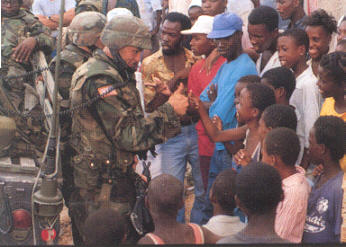
An additional shift in operational focus for the Battalion came in mid to late November 1994. The 1st Battalion 22nd Infantry was relieved of several of its static security missions in the city and was assigned to a new area of responsibility. This was the security of the national palace. The focus on security of the palace by the Division leadership was such that it was necessary to commit a larger force there with sole responsibility for the area.
The 1st Battalion 22nd Infantry left one rifle company and the Battalion's logistics elements at Warrior Base and moved all of the C2, one rifle company and the mounted special platoons of HHC to the palace to conduct the mission. The third rifle company remained assigned to the static security areas of responsibility that still belonged to the Battalion.
The scheme of maneuver had one rifle company in security and maintenance at Warrior Base, the second on static security at the remaining various sites in Port-au-Prince and the third was on twenty-four hour security on the palace and its grounds. That company was also on an internal rotating basis within the palace, as it had one rifle platoon in maintenance, another securing the perimeter, and the remaining platoon postured as a quick reaction platoon for use in and around the palace.
The Headquarters Company C2, with its three combat platoons, were designated a fourth maneuver company by the Battalion commander. The antitank and mortar platoons were already mobile on HMMWVs and were armed with Mark 19 grenade launchers and M60 machine guns on the AT Gun vehicles, and M60 machine guns on pedestal mounts for the cargo HMMWVs for the mortar platoon. The Battalion commander detached the Air Defense Artillery platoon's cargo HMMWVs and drivers to the HHC commander and the Battalion's scout platoon used them for mobility, also mounting M60 machine guns on pedestals. The remainder of the comapny was under the supervision of the company executive officer and first sergeant, pushing logistics packages, using the support platoon, from Warrior Base to all the deployed companies in and around Port-au-Prince.
The new mission for the HHC was to provide mounted and dismounted security for President Aristide's motorcade and to provide local security at any location that Aristide stopped or spent the night. This included security operations around Aristide's residence that was located several kilometers away from the palace, outside of Port-au-Prince.
Training for this mission began the week prior to Thanksgiving and was overseen by United States Department of State personnel who specialized in presidential security. Training focused on several critical tasks, the most important of which were driving skills (both offensive and defenseive), motorcade operations, communication between HHC, the Dept of State and Haitian security personnel, and vignette training geared toward insuring that the VIP in the motorcade was out of danger and away from any dangerous situation that developed as quickly as possible.
From 25 November 1994 through 15 January 1995, HHC 1/22 Infantry conducted seven actual motorcade missions. Most of the motorcades involved localized Port-au-Prince moves between the palace, the residence, or to and from political engagements within the city. One motorcade operation during the last week of November and the first week of December was a major Out of Sector move and spanned five days, as President Aristide conducted several speaking engagements along the southern claw of the Haitian country. The visits, with overnight stays, were in the towns of Les Cayes, Maragonne and the western most city of Jeremie.
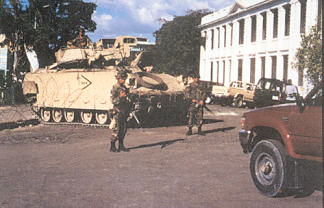
There was one major altercation between elements of 1/22 Infantry and the Haitian military (FAd'h) and police that occurred during the afternoon and evening of 26 December 1994.
The FAd'h and police headquarters building was located to the northwest of, and across the street from the palace and was situated on the north side of the central park traffic rotary adjacent to the west side of the national palace. The two story brick and mortar building was the scene, in September, of many negotiations between President Carter, his team of diplomats and LTG Cedras' faction. At the time C 1/22 Infantry was manning the perimeter of the palace and HHC, with two mounted platoons (AT and scouts) staged at the palace ready to respond to any required moves of President Aristide's motorcade.
Haitian soldiers had been gathering at the FAd'h headquarters starting about 22 December because they hadn't been paid for December. They were angry because the government announced they were not going to be paid and because of their summary dismissal. They'd been put on leave without explanantion until 17 January. The situation at the headquarters was a tinderbox. It was somewhat alleviated on the night of Friday 23 December, when COL Dallas and the MNF arranged for the payment of the soldiers. But the soldiers appeared again on the 26th at FAd'h headquarters. At that time a combination of various things, including strained relations, a very confusing situation, and armed soldiers who were scared and angry, resulted in a significant shooting incident.
Heavy weapons gunfire erupted at the FAd'h headquarters in the early afternoon, causing the Quick Reaction Platoon of C 1/22 Infantry to respond and deploy. The platoon maneuvered across the street and began assessing the situation after taking up positions around the perimeter fence of the FAd'h headquarters and effectively cordoned off the building. A call from the Battalion TOC alerted the HHC to assist by bolstering the cordon with the AT platoon and to maneuver and clear the building with the remaining dismounted scout platoon. The scout platoon and company headquarters C2 maneuvered out of the south side palace gate, as heavy gunfire continued to emanate from the FAd'h headquarters. As the HHC element maneuvered through the park and traffic rotary to link up with the C Company commander, the rifle platoon from C Company was fired upon, and engaged a number of unidentified assailants armed with M203 grenade launchers that appeared as though they were about to engage C Company, and possibly the HHC element with indirect fires. This direct action by the C Company platoon thwarted that potential attack.
Upon arrival of the HHC element and the Battalion Commander, COL Hawrylak, C Company was instructed to maintain the cordon, with the help of the AT platoon. HHC's C2 and its dismounted scout platoon were instructed to conduct a room by room and floor by floor search and clear operation to develop the situation and gain control of the building and its occupants. The HHC element cleared the first floor with no contact with Haitians, moved to the second floor and found several armed, uniformed Haitians in several different offices. All of the Haitians were dis-armed, secured, searched and detained. By days end there had been 3 Haitians killed, 7 wounded, 83 prisoners and 500 weapons seized.
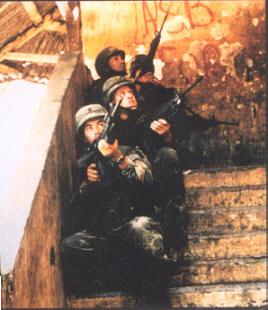

By mid-December 1994, 1/22 Infantry and the rest of First Brigade were informed they were to be relieved by elements of the 25th Division, stationed in Hawaii. Interestingly enough, 1/22 Infantry was directly relieved by its sister Battalion, 4/22 Infantry. The relief in place went off with out any problems and 1/22 Infantry was relieved of duties on or about 15 January 1995, and began returning home 20-21 January 1995.
For its part in Operation Uphold Democracy, 1st Battalion 22nd Infantry was again tasked to conduct a variety of missions. Initially, the Battalion was charged with providing security and stability with its presence and by patrolling in Port-au-Prince. Later, the mission was expanded to provide additional military support for the reintroduction of President Aristide into the country. This was further extended by the assignment of the Battalion as the sole military unit responsible for the security of the National Palace and for the personal safety of the Haitian President. That 1st Battalion accomplished this mission in an outstanding manner is attested to by the fact that there were no breaches of security at any time or location assigned to 1/22 Infantry's areas of responsibility, including the National Palace and the President's personal residence. Additionally, and most rewarding, was the personal praise President Aristide gave, just prior to the unit's redeployment, to all of the soldiers and leaders of HHC and the rest of 1/22 Infantry on their outstanding and professional performance while deployed to Haiti.
The accomplishments of Operation Uphold Democracy are summed up in the 10th Mountain Division's After Action Review:
Rapidly deployed over 20,000 military personnel throughout the country of Haiti
Stopped the political violence in Haiti
Insured the military regime departed by October 13
Created a stable and secure environment that allowed for the safe return of President Aristide
Assisted in the return of a democratically elected government and the restoration of a democracy in Haiti
Provided the people of Haiti the opportunity to "Hope" for the future
------------------------------------------------------------------------------
The above article was edited from the following sources:
TASK FORCE 1-22 INFANTRY FROM HOMSTEAD TO PORT-AU-PRINCE
by MAJ John Robert Evans
US Army Command and General Staff College document RWP-07-641281, 2 June 2000
and
OPERATION UPHOLD DEMOCRACY
10th Mountain Division After Action Review
Combined Arms Research Library, 24 August 1999
All photos are from the above 10th Mountain Division After Action Review
Home | Photos | Battles & History | Current |
Rosters & Reports | Medal of Honor | Killed
in Action |
Personnel Locator | Commanders | Station
List | Campaigns |
Honors | Insignia & Memorabilia | 4-42
Artillery | Taps |
What's New | Editorial | Links |